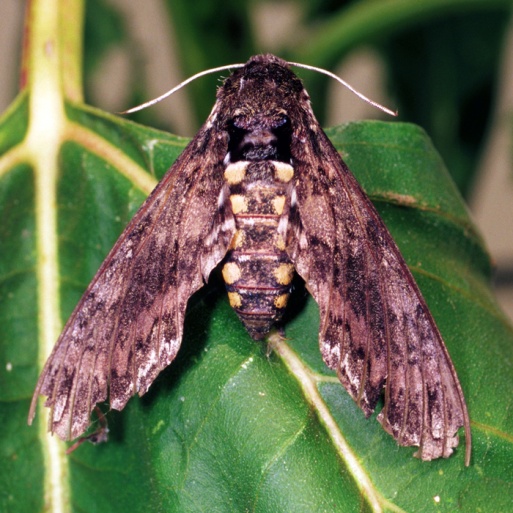
Tomato hornworm
Manduca quinquemaculata (Haworth)
(Insecta: Lepidoptera: Sphingidae)
Adult moths are grayish brown with five orange spots along each side of the abdomen. Their wings are narrow and spread to more than 100 mm. Eggs are spherical, about 1.5 mm in diameter, and light green to white. Larvae develop into large caterpillars more than 80 mm in length. They are green with eight white, V-shaped marks along each side of the abdomen and bear a characteristic black horn at the rear end. Pupae are up to 60 mm long, brown, and bear a conspicuous loop that encases the mouthparts. Larvae of the two hornworms (tobacco and tomato hornworm) can be distinguished by the shape of the white marks on the sides of the abdomen and the color of the horn at the rear end.
The life cycle may be completed in four to seven weeks, and depending on climate, two to four generations occur per year. Adults and larvae are active between April and November, and pupae overwinter in diapause. Moths are active and fly at dusk.
Although its distribution ranges from Canada to Argentina, tomato hornworm is especially common in the northern United States.
The host range is restricted to plants in the family Solanaceae, and tomato is the preferred host plant.
Images
To
save the Web-optimized images shown below to your hard drive:
PC users: right click to "Save Picture (or Image) As..."
Mac users: click and drag to your desktop.

Adult moth of tomato hornworm, Manduca quiquemaculata (Haworth)
(Photographer: Jim Occi, BugPics, Bugwood.org, with permission 2013-09-12)
Larvae of tomato hornworm, Manduca quiquemaculata (Haworth)
(Photographer: Whitney Cranshaw, Colorado State University, Bugwood.org, with permission 2013-09-12)